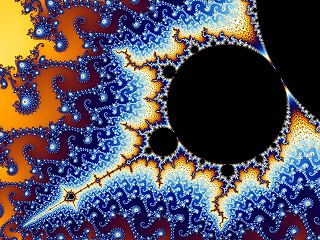This article was published in Scientific American’s former blog network and reflects the views of the author, not necessarily those of Scientific American

A portion of the Mandelbrot set, which may be the world's most famous fractal.
Credit: Wolfgangbeyer, via Wikimedia Commons. CC BY-SA 3.0
This year for MathPoetrymonth, I read Proportions of the Heart: Poems that Play with Mathematics, a collection of poems by Emily Grosholz. Grosholz is both a philosophy professor at Penn State and a poet. She does research in the philosophy of math, and her poems are peppered with references to both mathematics and its history. I highly recommend the collection.
In 2002, Grosholz appeared with Benoit Mandelbrot, father of fractal geometry, at an Entertaining Science event in New York. She wrote “In Praise of Fractals,” one of my favorite poems from her book, for the occasion.
On supporting science journalism
If you're enjoying this article, consider supporting our award-winning journalism by subscribing. By purchasing a subscription you are helping to ensure the future of impactful stories about the discoveries and ideas shaping our world today.
In Praise of Fractals
Variations on the Introduction to
The Fractal Geometry of Nature by Benoit Mandelbrot
(New York: W.H. Freeman and Company, 1983)
Euclid’s geometry cannot describe,
Nor Apollonius’, the shape of mountains,
Puddles, clouds, peninsulas or trees.
Clouds are never spheres,
Nor mountains cones, nor Ponderosa pines;
Bark is not smooth; and where the land and sea
So variously lie about each other
And lightly kiss, is no hyperbola.Compared with Euclid’s elementary forms,
Nature, loosening her hair, exhibits patterns
(Sweetly disarrayed, afloat, uncombed)
Not simply of a higher degree n
But rather of an altogether different
Level of complexity:
The number of the scales of distances
Describing her is almost infinite.How shall we study the morphology
Of the amorphous? Mandelbrot
Solved the conundrum by inventing fractals,
A lineage of shapes
Fretted by chance, whose regularities
Are all statistical, like Brownian motion,
Whose fine configurations
Turn out to be the same at every scale.Some fractal sets are curves
(Space-filling curves!) or complex surfaces;
Others are wholly disconnected ‘dusts’;
Others are just too odd to have a name.
Poincar? once observed,
There my be questions that we choose to ask,
But others ask themselves,
Sometimes for centuries, while no one listens.Questions that ask themselves without repose
May come to rest at last in someone’s mind.
So Mandelbrot in time
Designed his fractal brood to be admired
Not merely for its formal elegance
As mathematical structure,
But power to interpret, curl by curl,
Nature’s coiffure of molecules and mountains.What gentle revolution of ideas
Disjoins the nineteenth century from ours!
Cantor’s set of nested missing thirds,
Peano’s curve of fractional dimension,
Mandelbrot’s fractals, counter the old rule
Of simple continuity,
Domesticating what short-sightedly
Was once considered monstrous.Nature embraces monsters as her own,
Encouraging the pensive mathematician
To find anomaly
Inherent in the creatures all around us.
The masters of infinity,
Cantor, Peano, Hausdorff, and Lebesgue,
Discovered sets not in the end transcendent
But immanent, Spinoza’s darling Cause.Imagination shoots the breeze with Nature,
And what they speak (mathematics) as they flirt
Reveals itself surprisingly effective
In science, a wrought gift
We don’t deserve or seek or understand.
So let us just be grateful,
And hope that it goes on, although our joy
Is always balanced by our bafflement.
You can find out more about Emily Grosholz’s work on her website. You can read more math poetry here on my blog or in this link roundup. And if you’d like to learn more about the mathematical topics she mentions in the poem, here are some links to get you started.
How Long is the Coast of Britain?
Plane filling curves
Cantor set
Cantor dust
Fractal kitties
Henry Segerman’s developing terdragon curve, a fractal surface (video)
Fractal curves and dimension
Math’s Beautiful Monsters
The Unreasonable Effectiveness of Mathematics in the Natural Sciences
And of course the Mandelbrot set (video)